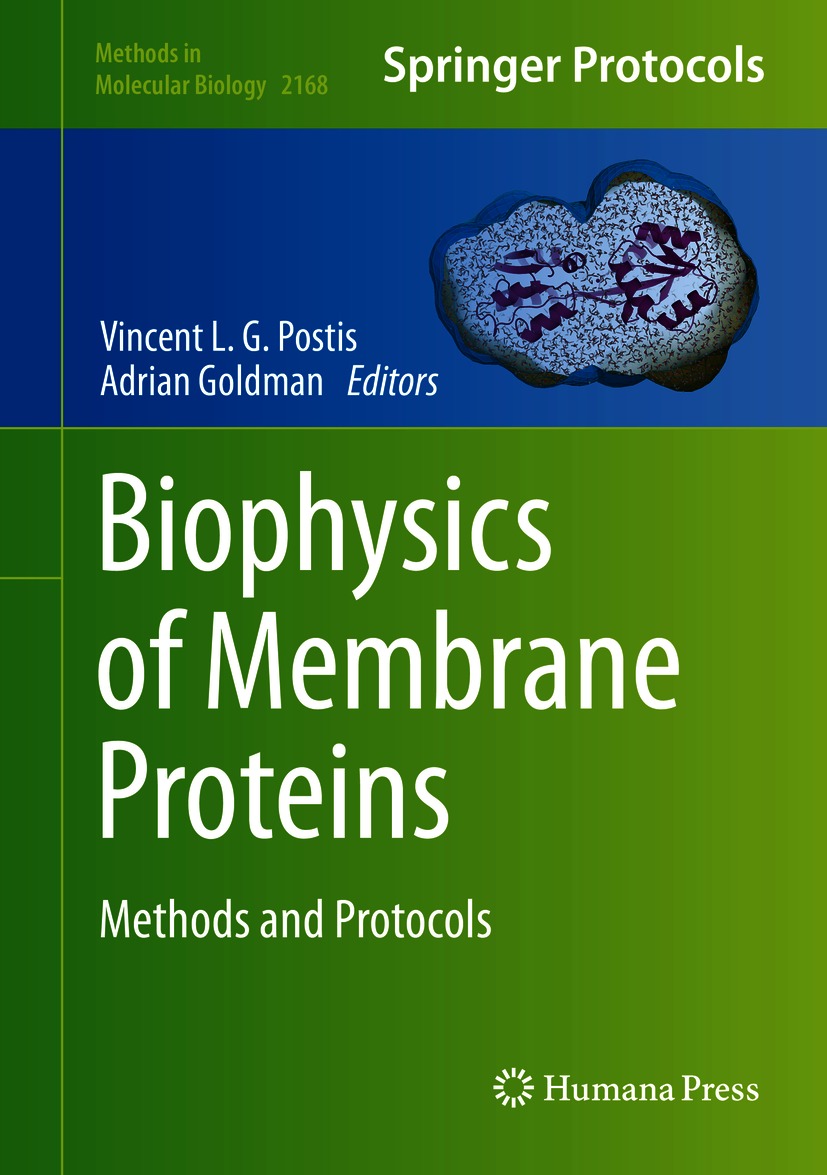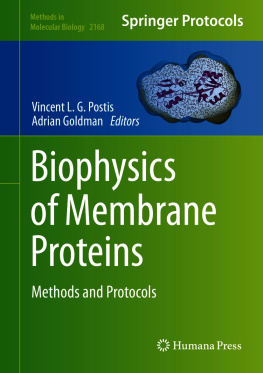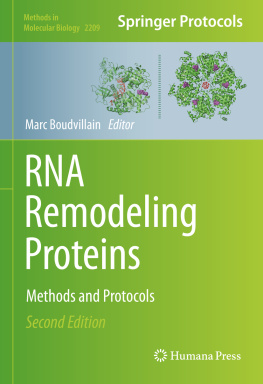Vincent L. G. Postis - Biophysics of Membrane Proteins: Methods and Protocols
Here you can read online Vincent L. G. Postis - Biophysics of Membrane Proteins: Methods and Protocols full text of the book (entire story) in english for free. Download pdf and epub, get meaning, cover and reviews about this ebook. year: 2020, publisher: Humana Press, genre: Home and family. Description of the work, (preface) as well as reviews are available. Best literature library LitArk.com created for fans of good reading and offers a wide selection of genres:
Romance novel
Science fiction
Adventure
Detective
Science
History
Home and family
Prose
Art
Politics
Computer
Non-fiction
Religion
Business
Children
Humor
Choose a favorite category and find really read worthwhile books. Enjoy immersion in the world of imagination, feel the emotions of the characters or learn something new for yourself, make an fascinating discovery.
- Book:Biophysics of Membrane Proteins: Methods and Protocols
- Author:
- Publisher:Humana Press
- Genre:
- Year:2020
- Rating:5 / 5
- Favourites:Add to favourites
- Your mark:
- 100
- 1
- 2
- 3
- 4
- 5
Biophysics of Membrane Proteins: Methods and Protocols: summary, description and annotation
We offer to read an annotation, description, summary or preface (depends on what the author of the book "Biophysics of Membrane Proteins: Methods and Protocols" wrote himself). If you haven't found the necessary information about the book — write in the comments, we will try to find it.
Biophysics of Membrane Proteins: Methods and Protocols — read online for free the complete book (whole text) full work
Below is the text of the book, divided by pages. System saving the place of the last page read, allows you to conveniently read the book "Biophysics of Membrane Proteins: Methods and Protocols" online for free, without having to search again every time where you left off. Put a bookmark, and you can go to the page where you finished reading at any time.
Font size:
Interval:
Bookmark:

For further volumes: http://www.springer.com/series/7651 For over 35 years, biological scientists have come to rely on the research protocols and methodologies in the critically acclaimed Methods in Molecular Biology series. The series was the first to introduce the step-by-step protocols approach that has become the standard in all biomedical protocol publishing. Each protocol is provided in readily-reproducible step-by step fashion, opening with an introductory overview, a list of the materials and reagents needed to complete the experiment, and followed by a detailed procedure that is supported with a helpful notes section offering tips and tricks of the trade as well as troubleshooting advice. These hallmark features were introduced by series editor Dr. John Walker and constitute the key ingredient in each and every volume of the Methods in Molecular Biology series. Tested and trusted, comprehensive and reliable, all protocols from the series are indexed in PubMed.
For over 35 years, biological scientists have come to rely on the research protocols and methodologies in the critically acclaimed Methods in Molecular Biology series. The series was the first to introduce the step-by-step protocols approach that has become the standard in all biomedical protocol publishing. Each protocol is provided in readily-reproducible step-by-step fashion, opening with an introductory overview, a list of the materials and reagents needed to complete the experiment, and followed by a detailed procedure that is supported with a helpful notes section offering tips and tricks of the trade as well as troubleshooting advice. These hallmark features were introduced by series editor Dr. John Walker and constitute the key ingredient in each and every volume of the Methods in Molecular Biology series. Tested and trusted, comprehensive and reliable, all protocols from the series are indexed in PubMed.

This Humana imprint is published by the registered company Springer Science+Business Media, LLC, part of Springer Nature.
The registered company address is: 1 New York Plaza, New York, NY 10004, U.S.A.
It is not an exaggeration to say that biological membranes and their components are the keys to life. Not only do they provide the barrier and the interface between cells and their environment, they also provide the boundaries that define internal organelles specialized in particular functions essential for the cellmitochondria, nuclei, lysosomes, and so on. Membranes physically compartmentalize incompatible metabolic processes within organelles and exclude toxic molecules from the cell. Besides lipids arranged in a bilayer, membranes are studded with a large variety of proteins fulfilling critical functions in all organisms: by some estimates, up to 70% of the area of the biological membrane is proteinaceous. Membrane proteins can have enzymatic functions, like the mitochondrial respiratory chain, or be involved in cell identification, interaction, and adhesion. Other membrane proteins such as channels, by controlling the ion flow across the membrane, regulate cell volumes and establish membrane potentials, the latter being central in everything from neuronal signaling to small molecule transport to ATP generation. Finally, membrane proteins can also serve as receptors to transmit signals or transporters to allow the transfer of both small molecules and macromolecules across the membranes.
Due to these critical roles in cellular function, it is not surprising that 70% of therapeutic targets are membrane proteins. However, despite their crucial functions and their central place in the pharmacopeia, the understanding of their structure and function remained limited for a long time. Since the turn of the century, the increased understanding of membranes has been driven by technological advances and methods developments which have led to an increase in known unique membrane protein structures. This, coupled with the improvement of biophysical techniques, has meant that the mechanism and dynamics of membrane proteins are starting to become clear.
This timely book aims to bring together the most recent advances in the field, offering insights from a global pool of experts. It is comprised of three parts: biochemical and functional analysis, experimental and theoretical structural determination, and studies of membrane protein dynamics and conformation. We focus on providing detailed and comprehensive protocols with notes that will be helpful for students, academics, and industrial scientists to further the understanding of membrane protein structure and function.
Font size:
Interval:
Bookmark:
Similar books «Biophysics of Membrane Proteins: Methods and Protocols»
Look at similar books to Biophysics of Membrane Proteins: Methods and Protocols. We have selected literature similar in name and meaning in the hope of providing readers with more options to find new, interesting, not yet read works.
Discussion, reviews of the book Biophysics of Membrane Proteins: Methods and Protocols and just readers' own opinions. Leave your comments, write what you think about the work, its meaning or the main characters. Specify what exactly you liked and what you didn't like, and why you think so.












